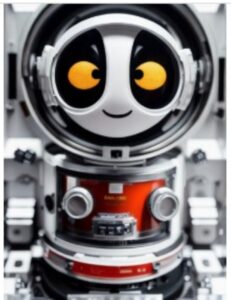Stage puppetry in the age of artificial intelligence: New innovations and broad horizons
Theater puppets have always played a vital role in enriching the imagination and presenting
unique theatrical performances. With the development of technology and the advancement
of artificial intelligence, the bridal industry has entered a new phase of innovation and creativity.
Instead of traditional materials, innovative materials appeared, and artificial intelligence algorithms
designed unparalleled puppet shapes, opening new horizons in the world of theater.
Innovative Materials in Puppetry
Recycled Materials:
The use of recycled materials, such as plastic, fabric, cardboard, and felt, has become an increasingly popular trend in puppetry. Not only does this serve an environmental purpose, but it also adds a unique artistic touch to each puppet.
Technological Materials:
Technological materials like fiber optics and flexible screens have found their way into puppetry, enabling the creation of interactive puppets capable of changing expressions and colors.
3D Printing:
3D printing has revolutionized the puppetry industry, allowing for the design and production of intricately detailed puppets in various sizes.
How has 3D printing changed puppetry?
-
Unrestricted Design: 3D printing allows designers to create complex and unconventional shapes for their puppets, breaking free from traditional molds.
-
Fine Details: Tiny parts and extremely fine details can be printed, making puppets more realistic.
-
Full Customization: Each puppet can be customized to suit the needs of a theatrical performance or the character being portrayed.
-
Rapid Prototyping: A prototype of a puppet can be printed quickly, allowing for adjustments and design evaluation before final production.
-
Mass Production: Multiple copies of the same puppet can be printed quickly and with high precision.
-
Diverse Materials: A wide range of materials can be used in 3D printing, including plastics, resins, and metals, allowing for various visual and tactile effects.
-
Custom Materials: New materials can be developed specifically for puppetry, such as flexible or transparent materials.
-
Reduced Costs: While the technology itself may be expensive initially, the cost of producing individual puppets is significantly reduced compared to traditional methods.
-
Small-Scale Production: Small quantities of puppets can be produced at a reasonable cost, making it suitable for independent and small-scale projects.
Additional Notes and Potential Improvements:
- Clarity and Conciseness: The translation aims to maintain the original meaning while using clear and concise language.
- Specificity: Terms like “fiber optics” and “flexible screens” could be further elaborated upon to provide a clearer understanding of their applications in puppetry.
- Visual Examples: Adding images or diagrams of puppets created using these materials and techniques would enhance the overall understanding of the topic.
- Future Trends: The translation could also touch upon future trends in puppetry, such as the integration of AI and robotics.
By incorporating these elements, the translation can provide a more comprehensive and engaging overview of the role of innovative
materials and 3D printing in the world of puppetry.








Artificial Intelligence in Puppet Design
- Generating Unique Designs: AI can generate thousands of unique puppet designs in record time, ranging from classic to highly abstract styles.
- Precise Customization: AI models can be trained on specific design styles, allowing for the creation of custom puppets to suit the theme of a performance or the character being portrayed.
- Enhanced Realism: AI can improve the realism of puppet designs by accurately simulating facial expressions and body movements.
- Interactive Performances: AI-designed puppets can be integrated into interactive performances where the puppets interact with the audience and respond to their actions.








Benefits of Using AI in Puppet Design
- Increased Productivity: AI can expedite the design and production process, saving time and effort.
- Diverse Designs: AI offers a wide range of unique designs, making it easier to select the perfect design for each performance.
- Enhanced Performance Quality: AI contributes to improving the quality of theatrical performances by providing more realistic and interactive puppets.
- Cost Reduction: AI can reduce the costs associated with traditional puppet design and production.
Challenges of Using AI in Puppet Design
- Need for Human Expertise: Despite the significant capabilities of AI, human expertise remains indispensable in the design and production process.
- Intellectual Property Protection: The intellectual property rights of designers and creators in the puppetry field must be protected.
- Initial Costs: The cost of developing and implementing AI technologies can be high.
The Future of Puppet Design with AI
The field of puppet design is experiencing rapid development thanks to AI, and we can expect to see in the future:
- More Interactive Performances: Puppets will interact directly with the audience.
- Smarter Puppets: Capable of learning and evolving over time.
- Integration of Virtual and Augmented Reality: Creating immersive experiences for viewers.
Additional Notes and Potential Improvements:
- Clarity and Conciseness: The translation aims to maintain the original meaning while using clear and concise language.
- Technical Accuracy: Terms like “AI models” and “simulate” are used to accurately convey the technical aspects of the process.
- Contextual Relevance: The translation is tailored to the specific context of puppet design and AI.
- Specificity: Terms like “expedite” and “contributes to” could be replaced with more specific verbs for a stronger impact.
- Future Outlook: The future section could be expanded to include more specific examples of how AI might be used in puppetry, such as creating AI-generated scripts or developing AI-powered puppetry software.
Example Sentence with Alternative Phrasings:
- Original: AI can expedite the design and production process, saving time and effort.
- Alternative: AI significantly streamlines the design and production pipeline, resulting in substantial time and cost savings.
.By considering these alternative phrasings and the additional notes, you can further refine the translation to meet your specific needs.

